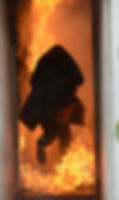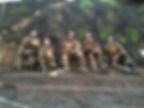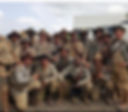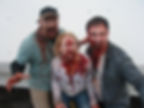10 considerations when choreographing a fight scene for a production
- Erol Mehmet
- Dec 21, 2019
- 8 min read
Updated: May 26, 2020

"I come here for a proper shootout! What you gonna do with that rolling pin? You gonna bake me a cake? What I want is a shootout." (Legend 2015)
And so the bar brawl began...

********
It's not just about throwing punches and hoping it looks good...
Many factors have to be taken into consideration when creating a fight scene for the big screen, TV or other productions. I’m not going to give away secrets or tricks of the trade or claim I am an expert at everything. I’m here to share my knowledge and experience that I have gained over 20+ years in the stunt business. I'm just going to cover the basics, touch on different aspects - the things that people ask me who are interested in what I do or they want to start a career in acting or stunt performing.
So...
In a nutshell...
Let's begin with this...
A choreographed fight scene for the big screen, TV or any other platform for entertainment is usually an impressive illusion of physical combat without causing harm to the performers.
That’s the goal anyway but accidents do happen sometimes, it's all part of the job.

Thankfully this look was all down to good makeup and lighting not a mistimed hit.
Obviously, there are different types of fight scenes and we will cover that in an other article. This is just a quick look at the many aspects of creating a realistic and safe fight scene for entertainment.
A quick bit about me...
I not only perform and choreograph fight scenes, I also chaperone actors during their performance on set, making sure whatever they contribute to a scene is done safely and effectively. With years of experience in the London Fire Brigade I have a good understanding of risk assessments and know how to handle a 'heated' (excuse the pun) performance where movements can go wrong with a misconception of timing and distance between two or a group of performers.

I have to admit, I was a bit hot under the collar that day!
So here we go... here are 10 considerations when choreographing a fight scene for a production:
1. Fight choreography and fighting style.
Fight scenes should be paced with consideration to:
Ability
Energy flow
Timing
Speed
Distance
Intensity
Control
Fight scenes should be structured around:
A beginning
A middle
An end
And compile of:
Hits
Hard hits
Defensive responses
Counter strikes
A give and take of power
A tug of war
Special effects if appropriate
Reactions
Emotions
A good fight scene should look visually compelling and capture an audience.
Just like this one:


'The Kingsman' church fight scene was very impressive and listed as one of the best fight scenes ever. It took weeks to complete.
There are many styles of fighting such as:
Boxing
Kung fu
Wrestling
Krav maja
Karate
I started karate when I was 12 years old and continued to enjoy different types of fighting for decades.


For me, learning to fight started from a need to express myself in a structured and disciplined environment and to keep fit. It built my confidence as a child growing up in Wandsworth where I had to become a bit streetwise to dodge pockets of trouble sometimes.
When I choreograph a fight scene I build up a list of simple moves in my head and perform the movements getting a feel for how it would work with a storyline and the setting. When working on a job, once I learn about who I will be working with I can then become more creative. Sometimes the fight scene has to be very structured but other times, if working with experienced performers, you can work with them and improvise between main shots - with safety top of mind all the time. Through all my years of experience, I would say a simple starting point with good communication between all involved is absolutely key to a good fight scene. As for performing, it's always rewarding when you get a 'great job' at the end of the day especially when it looks good on screen. That's another thing that is key, remembering to acknowledge achievement, we all feel good after a pat on the back.
Those points mentioned above are just the beginning of achieving an impressive fight scene.
Moving on...
2. It’s a team effort.
To achieve a good fight scene there needs to be a team effort between the stunt or/and fight coordinator, the director, the performers, the lighting team and the editor etc. There has to be a clear vision, good communication and honesty about abilities. When working with less experienced stunt performers or actors on a fight scene, educating them about the process of filming an action scene is important so they understand different aspects such as camera awareness and safety. I Learnt very early on - never presume everyone knows what they are doing, especially if props and weapons are being used.


It's great working with different directors, producers, stunt coordinators, performers and actors, it's an ongoing learning curve, understanding the way people like to work and how they achieve great results. It's the same whether the experience be on the big screen, TV or other performances.
3. Writing the fight scene...
A fight scene is normally born from part of a story line - a struggle to escape or a need to conquer for example. It's important to document a fight scene for many reasons including for the performers so they can rehearse the movements and for risk assessments purposes. For example, the document may contain a list of main hits in the fight scene and the different camera shots. A good fight scene should be action-packed and not slow down the story. It should be engaging with just enough detail making the audience feel like they are living the action. When incorporating weapons in a fight, those weapons need to be appropriate for the story. In a fantasy film the weapons can be fantastical, in a swashbuckling film the correct design of the sword normally has to match that of the period of the story. We will cover all those things like in more detail.


4. Health, safety and insurance.
Unfortunately, accidents sometimes happen on set for different reasons. Let’s take Jackie Chan for example, in one of his films Jackie’s hand was slashed on camera with a sharp sword. The crew accidentally used a real sword instead of a blunted one. Jackie Chan is one of the greatest stunt performers of all time, take a look at the ‘Ultimate list of Jackie Chan’s most painful injuries and broken bones’.
When choreographing a fight scene all safety aspects should be taken into consideration including insurance, risk assessments, testing equipment and props that are to be used in the scene. It is wise to check with a production company that they have insurance as well as having your own insurance if you are a performer or choreographer.

I was hot off my heels that day!
5. Rehearsals
There has to be adequate time for rehearsals, sometimes there are serious safety issues to consider and it’s really important to make sure everyone knows what they are doing. Another consideration when filming or performing is the use of ‘extras’ who are sometimes over-enthusiastic and keen to be seen in a production, this can add an aspect of danger as they sometimes get in the way of stunt performers. Everyone needs to know their role and their place.

So many things could have gone wrong at this point but thankfully they didn't.

Getting ready to go on set.

No swords this time.
6. Budget.
A production budget is typically split into creative talent (cast), direct production costs, post-production costs, insurance and completion bond, film promotion and marketing.
For example, the film ‘Unbreakable’ starring Bruce Willis and Samuel L. Jackson had a budget of $74,243,106 with $5,568,388 being allocated to some of the cast, casting, stunts and travel. Of that latter amount, a percentage of that would go to stunt and fight scenes with specific allowances for equipment and props. If the story line of the production involves a lot of fight scenes then obviously a larger budget would be required for that aspect.

Taking time out from the battlefield.
7. The setting and filming.
Setting the scene for a fight in a movie or other kind of production can involve many variables such as lighting, props, special effects, green screen, buildings, landscapes or the use of vehicles. The slaughtering of gladiators in a huge dusty ampitheatre, Apollo Creed's demise in the boxing ring or the intense fight scenes with Jackie Chan in buildings, sliding down buildings or throwing himself onto moving vehicles (he's done just about everything!).
Camera positioning is important sometimes the cameras are in one place or handheld.
The use of drones adds another dimension to a battle or fight scene. There are a wide range of camera lenses and different types of camera shots - low level, eye level and high level. Normally a director likes a selection of shots of different angles of a fight scene. An amazing stunt may not be appreciated so much if the lighting and camera angle isn't spot on. That's where team work comes in.








8. Props and weapons
By putting a prop into a fight scene it will break up the pace and give one performer the upper hand. It can lead to a unique style of fight choreography - the sword to the shield, staff to staff, chain to knives, chairs against daggers etc... You could call it 'chairography' or 'staffography' if you want to, everything has a name these days. There have been many slip ups with weapons in the history of filming and acting, Bruce Willis permanently lost part of his hearing whilst filming Die Hard. Willis had to fire a loaded gun from under a table that was loaded with extra loud blanks.



9. Cinematography and lighting.
Cinematography is about using the appropriate cinematic shots and lighting techniques. Lighting is an art form in itself - plot, mood, natural, artificial, special effects, selective visibility, projection, direction and focus - the list goes on. It can all get quite technical with different lumens, kelvins, cabling and controllers. There are back, fill and key lighting. Low, eye or high level Lighting. It is an aspect of a fight scene that is really important and can make a big difference, lighting choices are crucial to a film. In the film 'Lord of the Rings', there was a lot of use of natural and low key lighting creating shadows and a darker presence. In the film Rocky they used a lot of low key and three point focus lighting between the characters.


10. Costume and prosthetics.
Costumes and prosthetics help to bring a character to life but they can also take hours to put on and they can be extremely uncomfortable and restrictive. Have a bit of sympathy for the Teenage Mutant Ninja Turtles, their costumes weighed 60lbs with machinery installed in the shell on their backs. Each fight scene would leave them dehydrated and exhausted. The same goes for Malin Akerman who played Silk Spectra in Watchmen, the skin tight latex body suit would take an hour to get on and her body would start to go numb in places which made it really difficult to fight. There are many actors or stunt performers that will be able to tell you stories of them having to sometimes do 80 days of filming in costumes that took up to six hours a day to put on.


The heat was unbearable and the costume was so heavy!




That's not a great picture to end on.
A good storyline, capable film or TV crew, well cast actors and amazing sets and stunts can make for a great action movies. Such as:
Enter the Dragon
Casino Royale
John Wick
Kill Bill
The Matrix Reloaded
Transporter
Bourne Ultimatum
Mission Impossible
Gladiators
Crouching Tiger, Hidden Dragon
The list could go on and on, in fact, here are the 101 best action movies of all time according to Timeout.
I'll be back...
Coming soon '10 considerations when fighting with weapons'.
If you would like to know more about my services as a:
Fight Coordinator
Fight Choreographer
Stunt Performer
Fight Scene Safety Guardian
Fire Fighter


